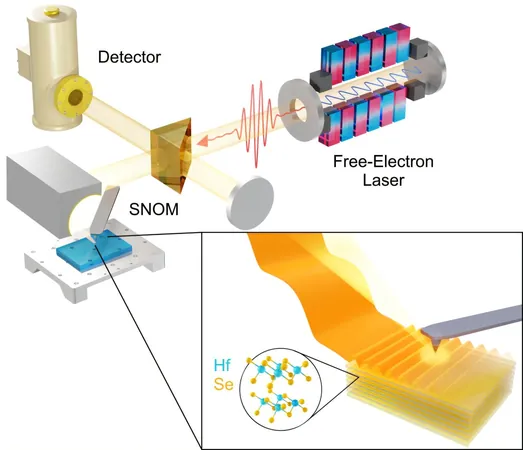
Breakthrough in Nanoscale Light Manipulation: Terahertz Waves Conquered!
2025-09-15
Author: Wei
Groundbreaking Research in Terahertz Technology
In an exciting advancement, scientists have successfully confined terahertz (THz) light to incredibly tiny dimensions using a novel layered material. This breakthrough, detailed in the prestigious journal *Nature Materials*, promises to revolutionize optoelectronic devices, impacting everything from infrared emitters in remote controls to night vision technologies and enhancing security through advanced environmental sensing.
The Power of Hafnium Dichalcogenides
The research, spearheaded by Josh Caldwell from Vanderbilt University alongside collaborators from Germany, reveals the potential of hafnium dichalcogenides—a composition of hafnium and elements like sulfur or selenium. By leveraging the unique properties of phonon polaritons, which merge photons with crystal lattice vibrations, the team has achieved an incredible compression of THz wavelengths—shrinking them from over 50 microns to under 250 nanometers with minimal energy loss.
Compressing Waves: A Revolutionary Analogy
In describing this impressive feat, Caldwell likens it to compressing massive ocean waves into a mere teacup, highlighting the over 200-fold reduction in wavelength confinement. This development paves the way for energy-efficient THz devices that could significantly impact technological advancements.
A Journey from Student Project to Major Scientific Discovery
Interestingly, this study began as a simple summer project for a high school student but rapidly evolved into a profound exploration of light and matter at the nanoscale. The interdisciplinary collaboration spanned notable institutions, leveraging advanced techniques in near-field optical microscopy that have been fine-tuned over 15 years at the Helmholtz-Zentrum Dresden-Rossendorf.
Leading the Future of THz Applications
The implications of this research are enormous. The extreme confinement of THz light could lead to the creation of ultra-compact THz waveguides and resonators, enhancing capabilities in vital areas like environmental monitoring and security imaging. Moreover, integrating these findings into van der Waals heterostructures could spark new discoveries and innovations in 2D materials technology.
A Vision for Tomorrow's Technology
This pioneering work not only positions hafnium dichalcogenides as a frontrunner for THz applications but also opens doors to exploring new realms of physics, such as ultra-strong light-matter coupling. With the potential for high-throughput material screening on the horizon, the future of THz technology is bright, promising even more breakthroughs that could transform the landscape of optoelectronic integration. "With our findings, we are pushing the boundaries of what is possible in THz technology," stated Paarmann.



 Brasil (PT)
Brasil (PT)
 Canada (EN)
Canada (EN)
 Chile (ES)
Chile (ES)
 Česko (CS)
Česko (CS)
 대한민국 (KO)
대한민국 (KO)
 España (ES)
España (ES)
 France (FR)
France (FR)
 Hong Kong (EN)
Hong Kong (EN)
 Italia (IT)
Italia (IT)
 日本 (JA)
日本 (JA)
 Magyarország (HU)
Magyarország (HU)
 Norge (NO)
Norge (NO)
 Polska (PL)
Polska (PL)
 Schweiz (DE)
Schweiz (DE)
 Singapore (EN)
Singapore (EN)
 Sverige (SV)
Sverige (SV)
 Suomi (FI)
Suomi (FI)
 Türkiye (TR)
Türkiye (TR)
 الإمارات العربية المتحدة (AR)
الإمارات العربية المتحدة (AR)